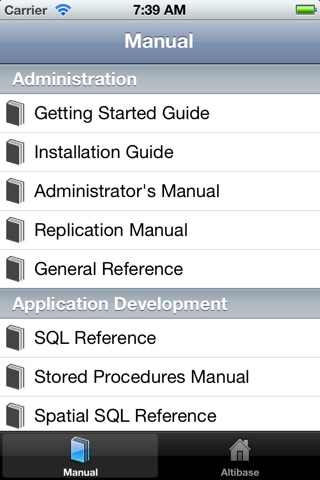
ALTIBASE HDB Manual app for iPhone and iPad
Developer: sparrowapps
First release : 01 Feb 2013
App size: 27.04 Mb
This app is ALTIBASE HDB Manual (6.1.1)
based ALTIBASE manual pdf documents file.
unofficial ALTIBASE manual app.
about ALTIBASE
www.altibase.com
ALTIBASE® HDB™: In-Memory DBMS with Hybrid Architecture
ALTIBASE® HDB™ is the only Hybrid DBMS in the industry that combines an in-memory DBMS with an on-disk DBMS, with a single uniform interface, enabling real-time access to large volumes of data, while simplifying and revolutionizing data processing.
Fastest Performance
Optimized for fastest transactional processing with the shortest response times measured in microseconds
Powered by special algorithms and data structures that are highly optimized for in-memory computing to avoid latency
Advanced techniques to achieve highest data throughput
Offers Innovative Concurrency and Data Consistency Controls
Complete Database
Fully ACID-compliant
Most Complete in-memory DBMS in the industry supporting a broad range of SQL standards
Compatible with all standard interfaces and programming languages (ODBC, JDBC, OLE DB, .Net, Java, C/C++, Precompiler)
Bundled with an abundance of Tools and Utilities for ease of use and enhanced productivity
Highly Available and Scalable
Built-in Replication Feature for High Availability and Scalability
Continuous transactional replication to support Active-Active and Active-Standby fault tolerance configurations
Shared-nothing Architecture
Adaptive Consistency supporting Synchronous and Asynchronous modes
Scalability and Load Balancing across 32-nodes over TCP/IP networks
Superior Flexibility
Combines the benefits of in-memory storage and on-disk storage in a single relational database.
The hybrid architecture empowers customers with the flexibility to run in three different modes; in-memory, on-disk or a combination of in-memory and on-disk.
Adjustable durability levels for varying application performance and consistency needs
Lower TCO
Lower License Fees
Lower Maintenance Fees
Efficient Utilization of System Resources



